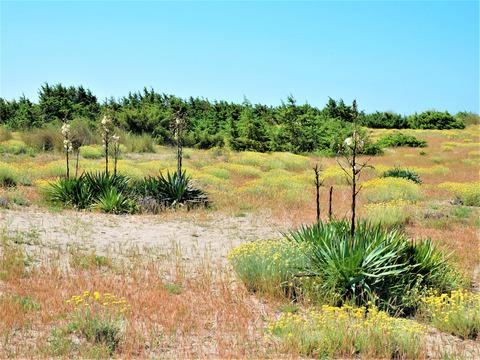当前位置:
X-MOL 学术
›
Journal of Vegetation Science
›
论文详情
Our official English website, www.x-mol.net, welcomes your
feedback! (Note: you will need to create a separate account there.)
Disentangling native and alien plant diversity in coastal sand dune ecosystems worldwide
Journal of Vegetation Science ( IF 2.2 ) Pub Date : 2020-11-18 , DOI: 10.1111/jvs.12961 Enrico Tordoni 1 , Giovanni Bacaro 1 , Patrick Weigelt 2 , Michela Cameletti 3 , John A.M. Janssen 4 , Alicia T.R. Acosta 5 , Simonetta Bagella 6 , Rossella Filigheddu 6 , Erwin Bergmeier 7 , Hannah L. Buckley 8 , Daniela Ciccarelli 9 , Estelle Forey 10 , Stephan M. Hennekens 11 , Roy A. Lubke 12 , Parastoo Mahdavi 7, 13 , Robert K. Peet 14 , Manuel Peinado 15 , Saverio Sciandrello 16 , Holger Kreft 2, 17
Journal of Vegetation Science ( IF 2.2 ) Pub Date : 2020-11-18 , DOI: 10.1111/jvs.12961 Enrico Tordoni 1 , Giovanni Bacaro 1 , Patrick Weigelt 2 , Michela Cameletti 3 , John A.M. Janssen 4 , Alicia T.R. Acosta 5 , Simonetta Bagella 6 , Rossella Filigheddu 6 , Erwin Bergmeier 7 , Hannah L. Buckley 8 , Daniela Ciccarelli 9 , Estelle Forey 10 , Stephan M. Hennekens 11 , Roy A. Lubke 12 , Parastoo Mahdavi 7, 13 , Robert K. Peet 14 , Manuel Peinado 15 , Saverio Sciandrello 16 , Holger Kreft 2, 17
Affiliation

|
Aims: i) To disentangle the global patterns of native and alien plant diversity on coastal sand dune ecosystems across habitats and floristic kingdoms, ii) to determine the main drivers of variation in species richness in native and alien species in these endangered ecosystems, and iii) to test for an interaction between spatial scale and native‐alien richness patterns, as predicted by the invasion paradox. Location: Global. Methods: We collated a dataset of 14,841 vegetation plots in coastal sand dune ecosystems from around the world. Generalized Linear Models (GLMs) and Generalized Linear Mixed Models (GLMMs) were used to assess the patterns and main ecological determinants underlying native and alien species richness. Variation partitioning revealed the relative importance of environmental and anthropogenic variables. Results: GLMs revealed strong differences among both habitats and floristic kingdoms in the number of native and alien species. Specifically, native species richness increased along the sea‐inland gradient and was higher in the Cape and Paleotropical kingdoms. In contrast, alien species richness was relatively similar across habitats and kingdoms, though some differences were detected. There were strong differences between the drivers of native and alien richness; anthropogenic factors such as Gross Domestic Product were positively associated with alien richness whereas native richness was more strongly related to environmental factors. Furthermore, we found a weak support for an invasion paradox effect. Conclusions: Our results revealed the complexity of causal processes underpinning coastal sand dune plant biodiversity and highlight the importance of considering native and alien species separately. Recognition of these differences while researching variation in biodiversity patterns and processes at multiple spatial scales will lead to a better mechanistic understanding of the causes of invasion worldwide, and in coastal ecosystems in particular, allowing the development of more focused control and management measures.
中文翻译:

解开全球沿海沙丘生态系统中本地和外来植物的多样性
目标:i) 理清整个栖息地和植物界的沿海沙丘生态系统上本地和外来植物多样性的全球模式,ii) 确定这些濒危生态系统中本地和外来物种物种丰富度变化的主要驱动因素,以及 iii ) 来测试空间尺度和外来物种丰富度模式之间的相互作用,正如入侵悖论所预测的那样。地点:全球。方法:我们整理了来自世界各地沿海沙丘生态系统中 14,841 个植被地块的数据集。广义线性模型 (GLMs) 和广义线性混合模型 (GLMMs) 用于评估本地和外来物种丰富度的模式和主要生态决定因素。变异划分揭示了环境和人为变量的相对重要性。结果:GLM 揭示了栖息地和植物界在本地和外来物种数量方面的巨大差异。具体而言,本地物种丰富度沿海陆梯度增加,在开普省和古热带王国更高。相比之下,不同栖息地和王国的外来物种丰富度相对相似,但也发现了一些差异。本土和外来财富的驱动因素之间存在很大差异;国内生产总值等人为因素与外来丰富度呈正相关,而本土丰富度与环境因素相关性更强。此外,我们发现对入侵悖论效应的支持较弱。结论:我们的研究结果揭示了支撑沿海沙丘植物生物多样性的因果过程的复杂性,并强调了分别考虑本地和外来物种的重要性。在研究多个空间尺度上生物多样性模式和过程变化的同时认识到这些差异,将有助于更好地了解全球入侵的原因,尤其是沿海生态系统,从而制定更有针对性的控制和管理措施。
更新日期:2020-11-18
中文翻译:

解开全球沿海沙丘生态系统中本地和外来植物的多样性
目标:i) 理清整个栖息地和植物界的沿海沙丘生态系统上本地和外来植物多样性的全球模式,ii) 确定这些濒危生态系统中本地和外来物种物种丰富度变化的主要驱动因素,以及 iii ) 来测试空间尺度和外来物种丰富度模式之间的相互作用,正如入侵悖论所预测的那样。地点:全球。方法:我们整理了来自世界各地沿海沙丘生态系统中 14,841 个植被地块的数据集。广义线性模型 (GLMs) 和广义线性混合模型 (GLMMs) 用于评估本地和外来物种丰富度的模式和主要生态决定因素。变异划分揭示了环境和人为变量的相对重要性。结果:GLM 揭示了栖息地和植物界在本地和外来物种数量方面的巨大差异。具体而言,本地物种丰富度沿海陆梯度增加,在开普省和古热带王国更高。相比之下,不同栖息地和王国的外来物种丰富度相对相似,但也发现了一些差异。本土和外来财富的驱动因素之间存在很大差异;国内生产总值等人为因素与外来丰富度呈正相关,而本土丰富度与环境因素相关性更强。此外,我们发现对入侵悖论效应的支持较弱。结论:我们的研究结果揭示了支撑沿海沙丘植物生物多样性的因果过程的复杂性,并强调了分别考虑本地和外来物种的重要性。在研究多个空间尺度上生物多样性模式和过程变化的同时认识到这些差异,将有助于更好地了解全球入侵的原因,尤其是沿海生态系统,从而制定更有针对性的控制和管理措施。











































 京公网安备 11010802027423号
京公网安备 11010802027423号